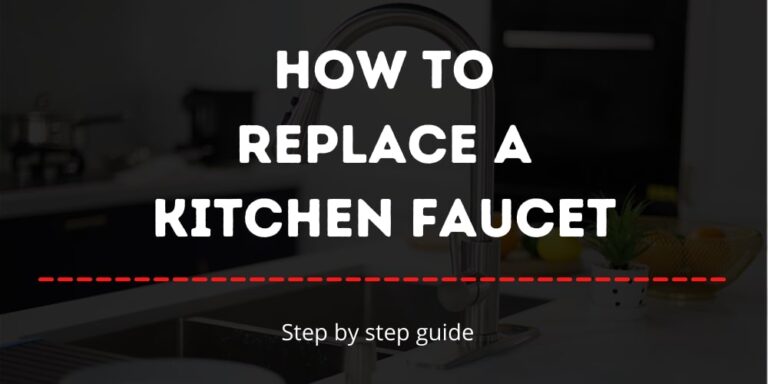Why Is My Delta Kitchen Faucet Spray Button Stuck?
A stuck spray mode in your Delta kitchen faucet can be an absolute nightmare, leading to unwanted water splashes and making cleaning up after meals a real pain. The good news is that this issue can be resolved with a few simple steps. In most cases, a clogged screen or faulty diverter is the root cause of a Delta kitchen faucet spray button stuck. Fortunately, fixing these parts can be an easy fix that requires minimal effort.
While kitchen sink sprayers are convenient features, they also require proper maintenance to function effectively. They make dishwashing and cleaning your sink much easier, but when the sprayer is stuck in spray mode, it can be frustrating.
If you find yourself in this situation, don’t worry. By adjusting or replacing the faulty parts, such as the spring, diverter, or screen, you can easily fix the issue. Stick around to learn more about how to fix a stuck spray mode in your Delta kitchen faucet and restore your sink to its former glory.
How To Fix Delta Kitchen Faucet Spray Button Stuck?

Dealing with a Delta kitchen faucet spray button stuck can be a major hassle, disrupting your daily routines and making simple tasks more complicated than they should be. Luckily, resolving this issue is often a straightforward process.
One of the primary culprits behind a Delta kitchen faucet getting stuck in spray mode is a faulty diverter valve. This valve directs the water flow between the faucet spout and the spray head. When it becomes stuck in one position and fails to switch back, that’s when the trouble begins.
Turn off Water
Before you embark on any repairs, it’s crucial to prioritize safety and prevent potential water damage. Always remember to turn off the water supply before proceeding.
Locate the shut-off valves positioned on either side of the faucet and turn them clockwise until they are completely closed. By doing so, you’ll safeguard your home from any accidental flooding or unintended consequences.
Check The Diverter Valve
If you’ve inspected the diverter valve and it appears to be in good condition, but the water flow problem persists, it’s time to shift your focus to the spray button itself. To determine if the spray button is the culprit, you can perform a simple test.
Employ a flathead screwdriver to press down on the button. If you encounter resistance or find that it remains stuck in place, it’s likely that the internal mechanism of the spray head is malfunctioning.
In such cases, it’s advisable to purchase a replacement spray head specifically designed for your kitchen faucet and install it accordingly. This will ensure a seamless flow of water and restore the functionality of your Delta kitchen faucet.
Clean The Diverter Valve
Disassembling the diverter is often necessary to address the issue effectively. Begin by utilizing a flathead screwdriver to unscrew the valve stem, allowing you to carefully extract it from the faucet spout.
Take a moment to inspect the diverter closely for any noticeable signs of wear, tear, or damage that may hinder its proper functionality. Should the diverter appear to be in good condition, carefully reinsert it back into its original position within the faucet. Then, it’s time to test the water flow once more to see if the problem has been resolved.
However, if the diverter shows clear indications of wear or damage, it’s prudent to replace it. Installing a new diverter is typically necessary in such cases to restore the optimal performance of your Delta faucet.
Clean the diverter valve well with a moderate cleaning solution, such as warm water and vinegar mixture. You can gently clean away any collected trash or mineral deposits with a tiny brush or toothbrush.
Pay close attention to the valve’s apertures and channels to ensure they are clear of impediments. This will help in the restoration of proper water flow.
To remove any remaining cleaning solution or residue, rinse the diverter valve with clean water.
Examine the valve for evidence of corrosion or wear. Replace any worn-out washers or O-rings with new ones as necessary to maintain optimal performance.
Verify that the diverter valve is entirely dry before reassembling. By doing this, future problems and the buildup of moisture will be avoided.
Put the diverter valve back in place and correctly align it once it has dried. Reattach the clip or tighten the retaining nut to keep it in place.
To check that the faucet is functioning properly, turn on the water supply. For assurance that water is being directed properly, check both the normal flow mode and the spray mode. Now the Delta kitchen faucet spray button stuck issue is solved.
Check also – Why Is Delta Touch Faucet Not Working?
Check These - Best Selling Products on Amazon (Shop Now and Save Big)
How To Unstuck a Kitchen Faucet Spray Head With Lubricants?

Dealing with a stuck button or lever on your kitchen sink can be a real headache. Various factors can contribute to this issue, such as the accumulation of mineral deposits, physical damage to the button or lever, or even internal parts rust over time.
Fortunately, there is a simple trick that can often provide some relief and get your kitchen sink sprayer working again and it is lubrication.
By applying a lubricant to the edges of the button or switch, you can help loosen things up and restore the smooth functionality you’re looking for. This method is quick and easy to try, offering a temporary solution to the immediate problem at hand.
However, it’s important to note that lubrication is typically considered a short-term fix, addressing the symptom rather than the underlying cause.
To achieve a more long-lasting resolution, it may be necessary to delve deeper into the root issue and address any underlying mineral buildup, physical damage, or rusting of internal components. By doing so, you can ensure the sustained functionality of your Delta kitchen faucet spray head and bid farewell to stubbornly stuck buttons or levers.
How Do You Take Apart a Delta Kitchen Faucet Spray Head?

Taking apart a Delta kitchen faucet spray head requires a thorough disassembly process to access its internal components for cleaning and maintenance. Here is a detailed step-by-step guide:
- Begin by turning off the water supply to your faucet. Look for the shut-off valves beneath the sink and turn them clockwise to close the water flow.
- Locate the connection point where the spray head attaches to the hose. Depending on your Delta faucet model, you will either find a threaded connection or a quick-connect fitting.
- For a threaded connection: Hold the spray head firmly with one hand to provide stability. Use an adjustable wrench to grip the connection point on the spray head. Turn the wrench counterclockwise to loosen the threaded connection. Once it is loose, you can continue unscrewing the spray head by hand.
- For a quick-connect fitting: Identify the plastic or metal collar where the spray head connects to the hose. This collar acts as a locking mechanism. Gently squeeze the collar and slide it down towards the hose to release the connection. With the collar depressed, twist and pull the spray head away from the hose.
- Once the spray head is detached, carefully inspect it for any visible mineral deposits, debris, or clogs. If you notice significant buildup, it’s recommended to soak the spray head in a solution of equal parts white vinegar and water for about 15-30 minutes. This helps dissolve mineral deposits and makes them easier to remove.
- After the soaking period, use a soft brush, such as a toothbrush, to scrub away any remaining deposits or debris from the spray head. Pay close attention to the small nozzles, crevices, and any removable parts.
- Rinse the spray head thoroughly with clean water to remove any vinegar or loosened deposits. Ensure that all the nozzles and openings are clear and free from any blockages.
- To reassemble the spray head, align it with the hose connection point. For a threaded connection, hand-tighten the spray head onto the hose, ensuring a secure fit. If necessary, use an adjustable wrench to tighten it slightly. For a quick-connect fitting, align the spray head with the hose and push it upward until you hear or feel it click into place.
- Once the spray head is reattached, turn on the water supply by opening the shut-off valves beneath the sink. Test the faucet to ensure proper water flow and functionality. Check that the spray mode and regular flow mode are working as expected.

Meet Ralph Matthews, father of 2 cute daughters and a skilled plumber with over 10 years of experience in the industry. Ralph has particular expertise in repairing any type of faucet and has helped countless homeowners and businesses solve their plumbing problems with his expert knowledge and attention to detail.






